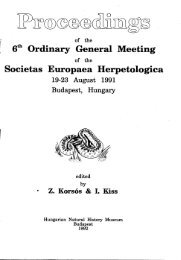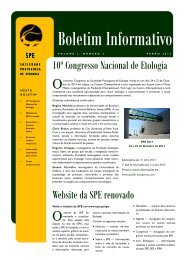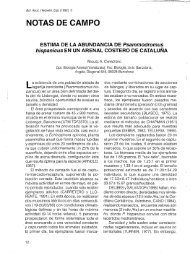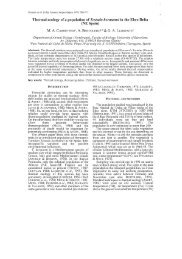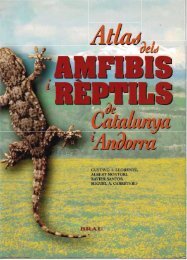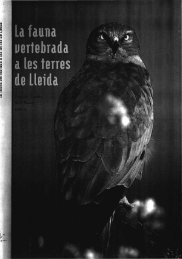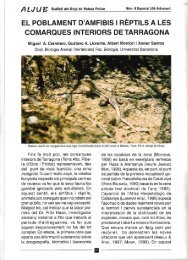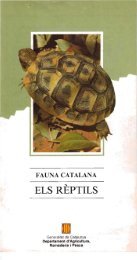Vipera aspis and V. latastei - Universidade do Porto
Vipera aspis and V. latastei - Universidade do Porto
Vipera aspis and V. latastei - Universidade do Porto
You also want an ePaper? Increase the reach of your titles
YUMPU automatically turns print PDFs into web optimized ePapers that Google loves.
Intermediate forms <strong>and</strong> syntopy among vipers (<strong>Vipera</strong> <strong>aspis</strong> <strong>and</strong> V.<br />
<strong>latastei</strong>) in Northern Iberian Peninsula<br />
FERNANDO MARTÍNEZ 1 *, JOSÉ C. BRITO 2,3 <strong>and</strong> MIGUEL LIZANA AVIA 1<br />
1 Dpto. Biología Animal, Parasitología, Ecología, Edafología y Química Agrícola, Facultad de<br />
Biología, Universidad de Salamanca, Campus Miguel de Unamuno, 37007 Salamanca, Spain<br />
2 CIBIO, Centro de Investigação em Biodiversidade e Recursos Genéticos, Instituto de Ciências<br />
Agrárias de Vairão, R. Padre Arm<strong>and</strong>o Quintas, 4485-661 Vairão, Portugal<br />
3 Dpto. Zoologia e Antropologia, Faculdade de Ciências da <strong>Universidade</strong> <strong>do</strong> <strong>Porto</strong>,<br />
4099-002 <strong>Porto</strong>, Portugal<br />
*Address for correspondence: Pazos de Reis, Circos 26. 36715 Tui, Pontevedra, Spain<br />
E-mail: flyssi@lycos.es<br />
THE general distribution pattern of the<br />
European vipers is mostly parapatric (Saint-<br />
Girons, 1980). However, several biogeographical<br />
studies conducted in contact zones between the<br />
distributions of different species confirm an<br />
allopatric distribution at a local scale (Saint-<br />
Girons, 1975; Saint-Girons, 1980; Saint-Girons &<br />
Duguy, 1976; Duguy & Saint-Girons, 1978;<br />
Monney, 1996; Bea, 1985; Naulleau, 1986; Brito<br />
& Crespo, 2002). Only a few cases of syntopy<br />
between European vipers have been reported,<br />
mostly between <strong>Vipera</strong> <strong>aspis</strong> <strong>and</strong> V. berus, such as<br />
in a narrow b<strong>and</strong> of 1–2 km in the Atlantic-Loire<br />
region, west of France (Saint-Girons, 1975), <strong>and</strong><br />
in a 70 ha area in the Pre-Alps, west of<br />
Switzerl<strong>and</strong> (Monney, 1996).<br />
In the Iberian Peninsula there are three viper<br />
species, one Euro-Siberian, V. seoanei, <strong>and</strong> two<br />
sibling Mediterranean species, V. <strong>aspis</strong> <strong>and</strong> V.<br />
<strong>latastei</strong> (Garrigues et al., 2005), which have<br />
several contact zones in their distribution areas.<br />
Biogeographical analysis of contact zones<br />
between no-sibling species, such as between V.<br />
seoanei <strong>and</strong> V. <strong>latastei</strong> in Peneda-Gerês National<br />
Park, northwest Portugal, or between V. seoanei<br />
<strong>and</strong> V. <strong>aspis</strong> in the Spanish Bask country, revealed<br />
differential habitat selection patterns, even<br />
opposite, suggesting an allopatric distribution at<br />
the local scale (Bea, 1985; Brito & Crespo, 2002).<br />
The two sibling species, V. <strong>aspis</strong> <strong>and</strong> V. <strong>latastei</strong>,<br />
exhibit a wide contact zone with populations in<br />
apparent sympatry south of the Pyrenees,<br />
northeast Spain (Pleguezuelos et al., 2002).<br />
However, V. <strong>aspis</strong> selects fresh <strong>and</strong> humid areas in<br />
north-faced slopes whereas V. <strong>latastei</strong> selects<br />
rocky <strong>and</strong> dry areas in south-faced slopes, thus no<br />
syntopy was detected (Duguy et al., 1979;<br />
Pleguezuelos & Santos 2002). In this area, some<br />
specimens are difficult to classify as belonging to<br />
V. <strong>aspis</strong> or V. <strong>latastei</strong> due to intermediate<br />
morphological traits between these vipers in the<br />
snout, shape <strong>and</strong> colour pattern (Duguy et al.,<br />
1979; Gosá, 1997).<br />
Sympatry between the three Iberian vipers was<br />
reported for an area located in the high course of<br />
Ebro River (Fig. 1A), between south-eastern of<br />
Sant<strong>and</strong>er <strong>and</strong> north-western of Burgos provinces,<br />
northern Spain (Duguy et al., 1979; Barbadillo<br />
1987; Pleguezuelos et al., 2002). In this area,<br />
sympatry was reported at a regional scale (10x10<br />
km UTM squares), but nothing was known at the<br />
local scale. In this note it is reported syntopy <strong>and</strong><br />
intermediate morphological traits between the two<br />
sibling Iberian vipers for northern Spain.<br />
The study area covers 1.200 km 2 <strong>and</strong> it is<br />
located in the transition between Euro-Siberian<br />
<strong>and</strong> Mediterranean regions (latitude 42º37.7’N to<br />
42º58.7’N <strong>and</strong> longitude 3º58.5’W to 3º37.3’W).<br />
It consists mostly in limy plateaus excavated by<br />
the Ebro River <strong>and</strong> its tributaries, Rudrón <strong>and</strong><br />
Panero rivers, forming canyons <strong>and</strong> sloppy valleys<br />
(Fig. 1B). Altitude ranges from 590 to 1256<br />
14 Herpetological Bulletin [2006] - Number 97
Intermediate <strong>Vipera</strong> in Northern Iberian Peninsula<br />
m.a.s.l. Climate is sub-humid Mediterranean with<br />
Central European tendency (Andrade, 1990).<br />
Although the most representative bioclimatic stage<br />
is the Supra-Mediterranean there are elements of<br />
the Mountain stage of the Euro-Siberian region,<br />
mostly in the northern <strong>and</strong> north-western areas<br />
(Rivas-Martínez 1987). Correspondingly, the<br />
climate is characterised by low levels of<br />
precipitation, average annual rainfall of 740<br />
mm/year (range: 614-959 mm/year), low average<br />
annual minimum temperature (-0.8ºC, ranging<br />
from -2.0 to 0.0ºC) <strong>and</strong> high average annual<br />
maximum temperature (25.9ºC, ranging from 22.8<br />
to 28.0ºC) (SIGA 2005).<br />
Between March 2004 <strong>and</strong> October 2005, visual<br />
encounter surveys based in UTM 1x1 km squares<br />
<strong>and</strong> road sampling were performed throughout the<br />
study area. Specimens were captured by h<strong>and</strong> <strong>and</strong><br />
their geographic location (UTM coordinates in the<br />
European-1950 datum) was recorded with a G.P.S.<br />
Specimens were sexed, measured, counted for<br />
Figure 1. A) Geographic location of the study area in<br />
the Iberian Peninsula. B) Distribution of the three vipers<br />
<strong>and</strong> the intermediate forms between <strong>Vipera</strong> <strong>aspis</strong> <strong>and</strong> V.<br />
<strong>latastei</strong> based on UTM 1x1 squares. C) Distribution of<br />
V. <strong>aspis</strong>, V. <strong>latastei</strong> <strong>and</strong> intermediate forms in the<br />
sympatry area.<br />
pholi<strong>do</strong>sis, photographed, <strong>and</strong> classified as V.<br />
seoanei, V. <strong>aspis</strong>, V. <strong>latastei</strong> or intermediate forms.<br />
Criteria for the classification of specimens<br />
included a combination of morphological traits: 1)<br />
snout elevation <strong>and</strong> number of apical scales: very<br />
small snout with two apical scales in V. seoanei,<br />
snout slightly upwards with two to three apical<br />
scales in V. <strong>aspis</strong> <strong>and</strong> snout upwards, forming an<br />
appendix with three to nine apical scales in V.<br />
<strong>latastei</strong> (Bea, 1998; Bea & Braña, 1998; Braña,<br />
1998a; Brito et al., 2006); 2) shape of the <strong>do</strong>rsal<br />
stripe: alternated cross b<strong>and</strong>s with a thin vertebral<br />
line (type 0) or narrow angular zigzag (type 1) in<br />
V. <strong>aspis</strong> (Bea, 1998), wide zigzag (type 2) or<br />
rounded-rhomboidal marks running together to<br />
Number 97 - Herpetological Bulletin [2006] 15
Intermediate <strong>Vipera</strong> in Northern Iberian Peninsula<br />
Figure 2. Three specimens collected in the sympatry<br />
area classified as intermediate forms between V. <strong>aspis</strong><br />
<strong>and</strong> V. <strong>latastei</strong>: sub-adult male with two apical scales,<br />
<strong>do</strong>rsal pattern type 2 <strong>and</strong> 51 <strong>do</strong>rsal marks (1, 2 <strong>and</strong> 3);<br />
adult male with three apical scales, <strong>do</strong>rsal pattern<br />
mixture of types 1/2, <strong>and</strong> 48 <strong>do</strong>rsal marks (4, 5 <strong>and</strong> 6);<br />
adult female with five apical scales, <strong>do</strong>rsal pattern<br />
mixture of types 1/2, <strong>and</strong> 46 <strong>do</strong>rsal marks (7, 8 <strong>and</strong> 9).<br />
form a wavy or zigzag stripe (type 3) in V. <strong>latastei</strong><br />
(Bea & Braña, 1998), <strong>and</strong> short alternated or<br />
opposite b<strong>and</strong>s with a wide vertebral line (type 4)<br />
in V. seoanei (Braña, 1998b); 3) number of <strong>do</strong>rsal<br />
marks: 60 to 80 in V. seoanei, 45 to 78 in V. <strong>aspis</strong><br />
<strong>and</strong> 33 to 57 in V. <strong>latastei</strong> (authors, unpublished<br />
data). Specimens were classified as intermediate<br />
forms when exhibiting contradictory or<br />
intermediate morphological traits.<br />
A total of 327 specimens were collected, 12<br />
belonging to V. seoanei, 138 to V. <strong>aspis</strong> <strong>and</strong> 124 to<br />
V. <strong>latastei</strong>. <strong>Vipera</strong> seoanei was restricted to the<br />
north <strong>and</strong> north-western zone of Euro-Siberian<br />
influence, <strong>and</strong> occupied pastures <strong>and</strong> mea<strong>do</strong>ws<br />
(Fig. 1B). At a local scale, no syntopy was found<br />
between V. seoanei with the other two vipers. This<br />
allopatric distribution seems to be similar to the<br />
pattern identified for north-western Portugal (Brito<br />
& Crespo, 2002), where differential habitat<br />
selection precludes sympatry. V. <strong>aspis</strong> was<br />
distributed throughout the central <strong>and</strong> northeastern<br />
zone while V. <strong>latastei</strong> occurred in the<br />
southern zone (Fig. 1B). Both species selected<br />
similar habitats, but V. <strong>aspis</strong> tended to select more<br />
humid habitats <strong>and</strong> with denser vegetation cover<br />
than V. <strong>latastei</strong>.<br />
<strong>Vipera</strong> <strong>aspis</strong> <strong>and</strong> V. <strong>latastei</strong> were located in<br />
sympatry in the central zone of the study area, in<br />
the middle-lower course of the Rudrón river, lower<br />
course of its tributary Sedanillo River <strong>and</strong> in La<br />
Lora Plateau (Fig. 1B). These were characterized<br />
by the abundance of ab<strong>and</strong>oned fields with<br />
disaggregated stone walls, herbaceous vegetation<br />
<strong>and</strong> thorny bushes. The sympatry area was a 15 km<br />
16 Herpetological Bulletin [2006] - Number 97
Intermediate <strong>Vipera</strong> in Northern Iberian Peninsula<br />
east-west oriented b<strong>and</strong> <strong>and</strong> a total of eight UTM<br />
1x1 km squares were detected with the two sibling<br />
species present (Fig. 1B <strong>and</strong> 1C). Fifty three<br />
specimens with intermediate morphological<br />
characteristics between V. <strong>aspis</strong> <strong>and</strong> V. <strong>latastei</strong><br />
were collected in 13 UTM 1x1 square mostly<br />
inside the sympatry area (Fig. 1C). These<br />
specimens presented two to five apical scales, the<br />
shape of the <strong>do</strong>rsal stripe including type 1, mixture<br />
of types 1/2 <strong>and</strong> types 2/3, <strong>and</strong> with 37 to 59 <strong>do</strong>rsal<br />
marks (Fig. 2). Intermediate forms were not<br />
observed in nearby populations of V. <strong>aspis</strong> to the<br />
north <strong>and</strong> V. <strong>latastei</strong> to the south (authors, personal<br />
observation). No intermediate specimens were<br />
detected between V. seoanei with V. <strong>aspis</strong> or with<br />
V. <strong>latastei</strong>.<br />
During spring mating season in the sympatry<br />
area some specimens of V. <strong>aspis</strong> <strong>and</strong> V. <strong>latastei</strong><br />
were found together in syntopy, forming part of<br />
mixed populations with typical specimens of each<br />
species <strong>and</strong> intermediate forms. The occurrence of<br />
intermediate forms <strong>and</strong> syntopy between<br />
specimens of both species during the reproductive<br />
period suggests that hybridization between V.<br />
<strong>aspis</strong> <strong>and</strong> V. <strong>latastei</strong> may occur. In order to<br />
enlighten this question <strong>and</strong> establish the<br />
correspondent evolutionary scenario according to<br />
the allopatric speciation theory (Brown &<br />
Lomolino, 1998; Garrigues et al., 2005), further<br />
studies about gene flow <strong>and</strong> comparative biology<br />
of these two sibling species are currently being<br />
developed.<br />
ACKNOWLEDGEMENTS<br />
This study was partially supported by the project<br />
POCTI/BIA-BDE/55596/2004 from Fundação<br />
para a Ciência e Tecnologia (FCT, Portugal). F.<br />
Martínez-Freiría was supported by PhD grant<br />
(AP2003-2633) from Ministerio de Educación,<br />
Cultura y Deporte (Spain) <strong>and</strong> J.C. Brito was<br />
supported by a Post-<strong>do</strong>ctoral grant<br />
(SFRH/BPD/11542/2002) from FCT. Authors<br />
acknowledge “Asociación Sociocultural Hoces del<br />
Alto Ebro y Rudrón”.<br />
REFERENCES<br />
Andrade, A. (1990). Atlas fitoclimático de España.<br />
Monografías I.N.I.A. 69. Madrid: Ministerio de<br />
Agricultura.<br />
Barbadillo, L.J. (1983). Sobre la distribucion de<br />
anfibios y reptiles en la provincia de Burgos.<br />
Bull. Soc. Catalana Ictiol. Herpetol. 5, 10–17.<br />
Bea, A. (1985). La repartición de las víboras<br />
<strong>Vipera</strong> <strong>aspis</strong> (Linnaeus, 1758) y <strong>Vipera</strong> seoanei<br />
(Lataste, 1879) en el Pais Vasco. Cuadernos de<br />
sección, Cienc. Nat., Eusko Ikaskunz 2, 7–20.<br />
Bea, A. (1998). <strong>Vipera</strong> <strong>aspis</strong> In: Fauna Ibérica.<br />
Vol. 10. Reptiles, pp. 469-480. Salva<strong>do</strong>r, A. (Coordinator).<br />
Museo Nacional de Ciencias<br />
Naturales. CSIC.<br />
Bea, A & Braña, A. (1998). <strong>Vipera</strong> latasti. In:<br />
Fauna Ibérica. Vol. 10. Reptiles, pp. 480-488.<br />
Salva<strong>do</strong>r, A. (Coordinator) Museo Nacional de<br />
Ciencias Naturales. CSIC.<br />
Braña, F. (1998a). Familiy Viperidae In: Fauna<br />
Ibérica. Vol. 10. Reptiles, pp. 466-469.<br />
Salva<strong>do</strong>r, A. (Coordinator). Museo Nacional de<br />
Ciencias Naturales. CSIC.<br />
Braña, F. (1998b). <strong>Vipera</strong> seoanei In: Fauna<br />
Ibérica. Vol. 10 Reptiles, pp. 489–497. Salva<strong>do</strong>r,<br />
A. (Coordinator). Museo Nacional de Ciencias<br />
Naturales. CSIC.<br />
Brito, J.C. & Crespo, E.G. (2002). Distributional<br />
analysis of two vipers (<strong>Vipera</strong> <strong>latastei</strong> <strong>and</strong> V.<br />
seoanei) in a potential area of sympatry in the<br />
Northwestern Iberian Peninsula. In: Biology of<br />
the Vipers, pp. 129–138. Schuett, G.W.,<br />
Höggren, M., Douglas, M.E., & Greene, H.W.<br />
(Eds.). Eagle Mountain Publishing.<br />
Brito, J.C., Santos, X., Pleguezuelos, J. M. Fahd,<br />
S., Llorente, G. A. & Parellada, X. (2006).<br />
Morphological variability of the Lataste’s viper<br />
(<strong>Vipera</strong> <strong>latastei</strong>) <strong>and</strong> the Atlas dwarf viper<br />
(<strong>Vipera</strong> monticola): patterns of biogeographical<br />
distribution <strong>and</strong> taxonomy. Amphibia-Reptilia,<br />
in press.<br />
Brown, J.H. & Lomolino, M.V. (1998).<br />
Biogeography. Sunderl<strong>and</strong>, Massachusetts:<br />
Sinauer Associates, Inc.<br />
Duguy,.R., Martínez-Rica, J. P., & Saint-Girons,<br />
H. (1979). La répartition des vipères dans les<br />
Pyrénées et les régions voisines du nord de<br />
l’Espagne. Bul. Soc. Hist. Nat. Toulouse 115,<br />
359–377.<br />
Duguy, R. & Saint-Girons, H. (1978). La<br />
répartition des vipères et de quelques autres<br />
reptiles sur le plateau de Millevaches<br />
Number 97 - Herpetological Bulletin [2006] 17
Intermediate <strong>Vipera</strong> in Northern Iberian Peninsula<br />
(Limousin). Ann. Soc. Sc. Nat. Charente-<br />
Maritime 6, 351–354.<br />
Garrigues,T., Dauga, C., Ferquel, E., Choumet, V.,<br />
& Failloux, A.-B. (2005). Molecular phylogeny<br />
of <strong>Vipera</strong> Laurenti, 1768 <strong>and</strong> the related genera<br />
Macrovipera (Reuss, 1927) <strong>and</strong> Daboia (Gray,<br />
1842), with comments about neurotoxic <strong>Vipera</strong><br />
<strong>aspis</strong> <strong>aspis</strong> populations. Molec. Phylog. Evol.<br />
35, 35–47.<br />
Gosá, A. (1997). <strong>Vipera</strong> <strong>aspis</strong>. In: Distribución y<br />
Biogeografía de los anfibios y reptiles en<br />
España y Portugal, pp. 285–287. Pleguezuelos,<br />
J.M. Monografías Tierra del Sur. Universidad<br />
de Granada. Asociación Herpetológica<br />
Española.<br />
Monney, J.-C. (1996). Biologie comparée de<br />
<strong>Vipera</strong> <strong>aspis</strong> L. et de <strong>Vipera</strong> berus L. (Reptilia,<br />
Ophidia, Viperidae) dans une station des<br />
Préalpes Bernoises. Thèse de Doctorat. Institut<br />
de Zoologie, Faculté des Sciences, Université<br />
de Neuchatel.<br />
Naulleau, G. (1986). Répartition de <strong>Vipera</strong> <strong>aspis</strong> et<br />
de <strong>Vipera</strong> berus (Reptilia, Viperidae), dans<br />
l’ouest de la France (Loire-Atlantique). Bull.<br />
Soc. Herpetol. France 39, 16–19.<br />
Pleguezuelos, J.M. Márquez, R. & Lizana, M.<br />
(Eds.) (2002). Atlas y libro rojo de los anfibios<br />
y reptiles de España. Dirección General de<br />
Conservación de la Naturaleza – Asociación<br />
Herpetológica Española, Madrid, 584 pp.<br />
Pleguezuelos, J.M. & Santos, X. (2002). <strong>Vipera</strong><br />
<strong>latastei</strong>. In: Atlas y libro rojo de los anfibios y<br />
reptiles de España, pp. 298–300. Pleguezuelos,<br />
J. M. Márquez, R. & Lizana, M. (Eds.).<br />
Dirección General de Conservación de la<br />
Naturaleza – Asociación Herpetológica<br />
Española, Madrid.<br />
Rivas-Martínez, S. (1987). Memoria del mapa de<br />
series de vegetación de España. Publicaciones<br />
del Ministerio de Agricultura, Pesca y<br />
Alimentación. ICONA.<br />
Saint-Girons, H. (1975). Coexistence de <strong>Vipera</strong><br />
<strong>aspis</strong> et de <strong>Vipera</strong> berus en Loire-Atlantique: un<br />
probleme de competition interspecifique. Terre<br />
Vie 29, 590–613.<br />
Saint-Girons, H. (1980). Biogéographie et<br />
évolution des vipéres européennes. C.R. Soc.<br />
Biogeogr. 496, 146–172.<br />
Saint-Girons, H. & Duguy, R. (1976). Écologie et<br />
position systématique de <strong>Vipera</strong> seoanei<br />
Lataste, 1879. Bull. Soc. Zool. France 10,<br />
325–339.<br />
SIGA (2005). Servicio de Información<br />
Geográfico Agrario, Ministerio de<br />
Agricultura, Pesca y Alimentación, Spain.<br />
http://www.mapya.es/es/sig/pags/siga/intro.htm<br />
Spelerpes variegatus = Bolitoglossa mexicana. Reproduced from an original lithographic plate<br />
in Biologia Centrali-Americana; Reptila <strong>and</strong> Batrachia (Albert C. L. G. Gunther, 1902).<br />
18 Herpetological Bulletin [2006] - Number 97



